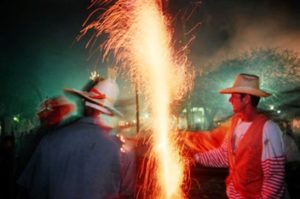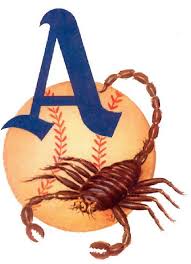 FRASE POPULAR CUBANA: “SALIÓ COMO UN VOLADOR DE A PESO”.
FRASE POPULAR CUBANA: “SALIÓ COMO UN VOLADOR DE A PESO”.
La pirotecnia tal y como hoy la entendemos nace con el descubrimiento de la pólvora negra y éste se produce, según documentación en China, en el siglo IX de nuestra era, bajo la dinastía Thang, por uno o varios alquimistas desconocidos.
El cohete volador, es sin duda la pieza más antigua de fuego aéreo, atestiguada en China ya en el siglo XII de nuestra era, y las dimensiones del cartucho (sin la cana o timón) pueden variar extraordinariamente, desde unos 6 por 40 mm hasta 25 por 200.
A un monje chino llamado Li Tian, se le acredita la invención de los fuegos artificiales.
Se dice que cuando George Washington fue juramentado como el primer presidente de Estados Unidos en la lejana fecha de abril de 1789, todas las campanas repicaron de júbilo y alegría, y la ciudad estaba iluminada con fuegos artificiales en la noche.
Los fuegos artificiales, hacen su aparición en Europa, en la Italia de fines del quattrocento, como una actividad típicamente artesanal, que difícilmente podrá ser mecanizada sin perder algunas de sus virtudes más sobresalientes.
Florencia parece haber sido el centro de este suceso, que conoció un gran auge durante el siglo XVI, con espectáculos de fuegos artificiales ofrecidos frecuentemente en fiestas cívicas o religiosas y, sobre todo, el día de San Pedro y San Pablo.
En Cuba los cohetes voladores iluminan la noche y la mente de los cubanos para crear frases populares.
En Cuba como en otros países latinos la pirotecnia llegó también muy temprano y aunque no existen apuntes bien fundamentados al respecto en las fiesta navideñas y celebraciones religiosa y patrióticas de antaño los fuegos artificiales constituian motivos de singular interés.
En Jaruco, una ciudad ubicada en las afueras de La Habana, Porfirio Hernández, alias “el piloto”, que cobró fama por sus enconados debates callejeros sobre béisbol, disparaba uno de aquellos estruendosos dispositivos cuando su equipo Almendares gana el juego.
La picaresca criolla se encargó de introducir al habla de hombres, mujeres y niños una locución relacionada con el más sonoro y rápido de los artefactos empleados y que en la década del 40 del siglo XX tenía un costo de un peso en todo el territorio nacional.
La velocidad con que este explosivo se eleva al cielo y su precio de venta al público en aquella época, coincidieron y entonces, nació la frase como un volador de a peso, para identificar los rápidos movimientos de alguna o varias personas al andar.
 CUBAN POPULAR PHRASE: “IT FLEW AS A ONE DOLLAR ROCKET”.
CUBAN POPULAR PHRASE: “IT FLEW AS A ONE DOLLAR ROCKET”.
The pyrotechnics as we understand it today is born with the discovery of black powder and this is produced, according to documentation in China, in the ninth century of our era, under the Thang dynasty, by one or several unknown alchemists.
The flying rocket is undoubtedly the oldest piece of aerial fire, attested in China as far back as the twelfth century AD, and the dimensions of the cartridge (without the tiller or rudder) can vary dramatically, from about 6 by 40 mm to 25 for 200.
A Chinese monk named Li Tian is credited with the invention of fireworks.
It is said that when George Washington was sworn in as the first president of the United States on the distant date of April 1789, all the bells rang with jubilation and joy, and the city was lit with fireworks at night.
The fireworks, make their appearance in Europe, in the Italy of the end of the quattrocento, as a typical craft activity, which can hardly be mechanized without losing some of its most outstanding virtues.
Florence seems to have been the center of this event, which experienced a great boom during the sixteenth century, with fireworks displays frequently offered at civic or religious festivals and, above all, the day of San Pedro and San Pablo.
In Cuba, flying rockets illuminate the night and the minds of Cubans to create popular phrases.
In Cuba as in other Latin countries the pyrotechnics also arrived very early and although there are no well-founded notes on the matter in the Christmas parties and religious and patriotic celebrations of yesteryear the fireworks constituted reasons of singular interest.
In Jaruco, a city located in the outskirts of Havana, Porfirio Hernández, alias “el piloto”, who gained fame for his bitter street debates about baseball, fired one of those thunderous devices when his Almendares team wins the game.
The picaresque Creole was in charge of introducing to the speech of men, women and children a phrase related to the most sonorous and rapid of the devices used and that in the decade of 40 of the XX century it had a cost of a weight in all the national territory.
The speed with which this explosive rises to the sky and its price for sale to the public at that time, coincided and then, the phrase was born as a flying weight, to identify the rapid movements of one or more people when walking.
Agencies/ Arrajatabla/ Alberto Denis/ Internet Photos/ Arnoldo Varona/ www.TheCubanHistory.com
THE CUBAN HISTORY, HOLLYWOOD.



 < CUBAN Popular Phrase: "It Flew as a One Dollar Rocket".
< CUBAN Popular Phrase: "It Flew as a One Dollar Rocket".




